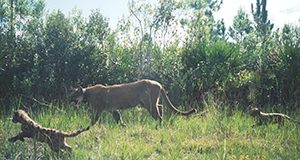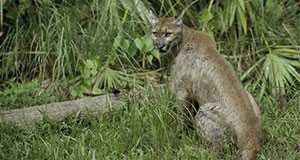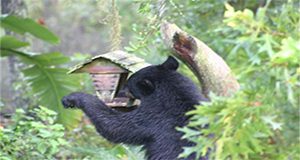As the number of feral cats continues to increase, land managers, public health officials, and private citizens are voicing concerns about how to address the nuisance and public health impacts, as well as animal welfare concerns, that feral cats create. Trap-neuter-release programs aimed at reducing feral cat populations without euthanasia are gaining popularity in the United States. But do they work? Authors Mark Hostetler, Samantha M. Wisely, Steve Johnson, Elizabeth F. Pienaar, and Martin Main discuss the pros and cons of trap-neuter-release programs in this 8-page fact sheet published by the UF/IFAS Department of Wildlife Ecology and Conservation.
https://edis.ifas.ufl.edu/uw468
Tag: Elizabeth F. Pienaar
Did I See a Panther?
Florida panthers can sometimes be confused with bobcats, dogs, and coyotes. This 4-page fact sheet written by Diane J. Episcopio, Elizabeth F. Pienaar, and Martin B. Main and published by the UF/IFAS Department of Wildlife Ecology and Conservation describes how to identify panthers by their physical characteristics and their tracks and explains what to do if you have seen a panther.
edis.ifas.ufl.edu/uw144
Securing Pet Food from Florida Black Bears and Coyotes
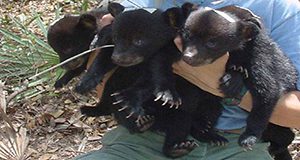
The Florida black bear and the coyote are both prevalent throughout the state of Florida. The number one cause of human-wildlife conflict for these two species are food attractants, including pet food. This 2-page fact sheet written by Kelley C. Anderson and Elizabeth F. Pienaar and published by the UF/IFAS Department of Wildlife Ecology and Conservation explains how to secure pets and pet food against both the Florida black bear and the coyote and keep people, pets, and wildlife safe.
edis.ifas.ufl.edu/uw437
Land Trusts in Florida: A Brief Guide to Land Trusts
A land trust is a private nonprofit organization that owns and manages land to protect its natural, economic, and cultural value. Land trusts may also educate the public about local conservation efforts. This two-page factsheet written by Benjamin W. North and Elizabeth F. Pienaar and published by the UF/IFAS Department of Wildlife Ecology and Conservation explains the important role land trusts play and provides tips on how to establish a land trust to protect land in your community.
http://edis.ifas.ufl.edu/uw436
Reducing Human-Bear Conflicts: Bear-Resistant Trash Cans
The Florida black bear (Ursus americanus floridanus) is the only species of bear in Florida, with an estimated population of approximately 4,030 bears. Bears that eat garbage put themselves in danger. This 3-page fact sheet written by Ethan T. Noel, Elizabeth F. Pienaar, and and Mike Orlando and published by the Wildlife Ecology and Conservation Department explains how to secure human garbage from bears so that they don’t become reliant on human food sources, a condition that puts them at great risk of being killed from vehicle collisions, illegal shooting, or euthanasia.
http://edis.ifas.ufl.edu/uw429
Securing Bird Feeders from Florida Black Bears
The Florida black bear (Ursus americanus floridanus) is the only species of bear in Florida, with an estimated population of approximately 4,030 bears. Bears are excellent climbers and can access bird feeders that are suspended from trees. This 3-page fact sheet written by Ethan T. Noel and Elizabeth F. Pienaar and published by the Wildlife Ecology and Conservation Department explains how to secure bird seed from bears so that they don’t become reliant on human food sources, a condition that puts them at greater risk of being killed from vehicle collisions, illegal shooting, or euthanasia.
http://edis.ifas.ufl.edu/uw430
Protecting Florida Panthers by Protecting Domestic Animals: Building a "Panther-Proof" Pen
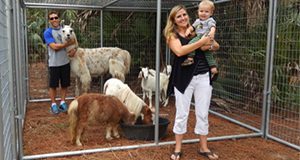
Florida panthers once ranged throughout most of the southeastern United States, but loss of habitat and efforts to eradicate panthers during the 1800s led to a large decline throughout much of their historic range. Florida panthers were listed as an endangered species in 1967 and have been federally protected by the US Endangered Species Act since 1973. For the most part, the role of panthers in the natural environment benefits people (they prey on burgeoning populations of white-tailed deer, raccoons, opossums, and feral hogs). Panthers do sometimes kill pets and livestock in rural and residential areas in southwest Florida, however, and some people believe that panther kills happen because panther populations have grown too large or are not well-managed. In fact, the panther population is dangerously small, and most of these losses can be attributed to poor management not of panthers but of pets and livestock. To maintain support for panther conservation, it is paramount that rural residents protect and secure their pets and livestock. This 3-page fact sheet written by Phillip D. Rodgers, Elizabeth F. Pienaar, Mark Lotz, and Darrell Land and published by the UF Department of Wildlife Ecology and Conservation explains how to make a locking, secure enclosure to protect livestock from panther predation–and protect the fragile panther, as well.
http://edis.ifas.ufl.edu/uw423
Government Efforts to Protect Habitat for the Florida Panther on Private Lands
Endangered Florida panthers live and breed on state and federal lands in south Florida, but they are a wide-ranging species, and the habitat available to them on public lands is not enough for them to thrive and recover. The 2008 Panther Recovery Plan by the US Fish and Wildlife Service requires that habitat for the panther be conserved on both public and private lands throughout the state. Private rangelands in southwest and south central Florida provide important habitat and prey for the Florida panther. These lands also play a key role in conserving other native species like gopher tortoises, bob white quail, turkeys, deer, vultures, scrub jays, cranes, black bears, and bobcats. Unfortunately, these rangelands are under increasing development pressure as the human population in Florida continues to grow. Multiple policy approaches have been put in place by local, state, and federal governments to address habitat loss and secure natural resources in Florida for our panthers. This 5-page fact sheet written by Elizabeth F. Pienaar and Melissa M. Kreye and published by the Department of Wildlife Ecology and Conservation provides a brief overview of existing regulatory and voluntary approaches to help conserve the Florida panther on private lands.
http://edis.ifas.ufl.edu/uw413
Safe Harbor Agreement: A Regulatory Assurance under the Endangered Species Act
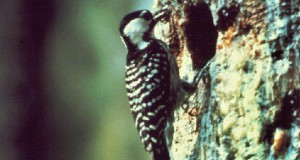
The involvement of the private sector is critical for the conservation and recovery of many species, but landowners’ fears that increased management restrictions could keep them from enjoying their land can present a challenge to securing their trust and assistance in conservation efforts. A Safe Harbor Agreement is a regulatory assurance that removes the risk of additional regulation in the future and encourages landowners to maintain important habitat on their lands. This three-page publication written by Melissa M. Kreye, Elizabeth F. Pienaar, Raoul K. Boughton, and Lindsey Wiggins and published by the Wildlife Ecology and Conservation Department provides Extension agents, decision-makers, and landowners with a basic understanding of a landowner’s obligations and the benefits of enrolling.
http://edis.ifas.ufl.edu/uw403
Habitat Requirements of the Florida Panther
 The Florida panther (Puma concolor coryi) was listed as endangered under the Endangered Species Act in 1967. Habitat loss and fragmentation are primary threats, driven by urban development and the conversion of rangelands to row crops, citrus production, and mining. This 3-page fact sheet focuses on which habitats are most important for conservation of the Florida panther. Written by Elizabeth F. Pienaar and Elena C. Rubino, and published by the UF Department of Wildlife Ecology and Conservation, October 2014. (Photo courtesy of the Florida Fish and Wildlife Conservation Commission.)
The Florida panther (Puma concolor coryi) was listed as endangered under the Endangered Species Act in 1967. Habitat loss and fragmentation are primary threats, driven by urban development and the conversion of rangelands to row crops, citrus production, and mining. This 3-page fact sheet focuses on which habitats are most important for conservation of the Florida panther. Written by Elizabeth F. Pienaar and Elena C. Rubino, and published by the UF Department of Wildlife Ecology and Conservation, October 2014. (Photo courtesy of the Florida Fish and Wildlife Conservation Commission.)
http://edis.ifas.ufl.edu/uw390
Conflicts between People and the Florida Black Bear
 An adult black bear may eat up to the equivalent calorie content of 38 Big Mac sandwiches a day, and can smell food from one to two miles away. Garbage is the main attractant, but bears are also attracted by bee hives, pet food, barbeque grills, fruit trees, and bird (or wildlife) feeders. Conflicts between people and black bears arise when people fail to remove or secure potential food sources. In their search for food, black bears may damage property and threaten, injure, or kill pets and livestock in order to gain access to their feed. This 5-page fact sheet provides tips for preventing human-bear conflicts and tells how to report conflicts if they happen. Written by Elizabeth F. Pienaar, and published by the UF Department of Wildlife Ecology and Conservation, September 2014.
An adult black bear may eat up to the equivalent calorie content of 38 Big Mac sandwiches a day, and can smell food from one to two miles away. Garbage is the main attractant, but bears are also attracted by bee hives, pet food, barbeque grills, fruit trees, and bird (or wildlife) feeders. Conflicts between people and black bears arise when people fail to remove or secure potential food sources. In their search for food, black bears may damage property and threaten, injure, or kill pets and livestock in order to gain access to their feed. This 5-page fact sheet provides tips for preventing human-bear conflicts and tells how to report conflicts if they happen. Written by Elizabeth F. Pienaar, and published by the UF Department of Wildlife Ecology and Conservation, September 2014.
http://edis.ifas.ufl.edu/uw389
Valuing the Recreation Uses of Natural Resources: The Travel Cost Method
 Many available statistics provide evidence that outdoor recreation in Florida generates economic value, but these data do not capture the full recreation value of Florida’s natural resources. The Travel Cost Method (TCM) approach may be applied in cost-benefit analysis and in natural resource damage assessments where recreation values are relevant. This 8-page fact sheet summarizes and synthesizes economic texts on TCM and provides an overview of a case study in which the TCM was used to estimate the nature-based recreation use value of the Apalachicola River Region in Florida. Written by Elizabeth F. Pienaar, and published by the UF Department of Wildlife Ecology and Conservation, January 2014.
Many available statistics provide evidence that outdoor recreation in Florida generates economic value, but these data do not capture the full recreation value of Florida’s natural resources. The Travel Cost Method (TCM) approach may be applied in cost-benefit analysis and in natural resource damage assessments where recreation values are relevant. This 8-page fact sheet summarizes and synthesizes economic texts on TCM and provides an overview of a case study in which the TCM was used to estimate the nature-based recreation use value of the Apalachicola River Region in Florida. Written by Elizabeth F. Pienaar, and published by the UF Department of Wildlife Ecology and Conservation, January 2014.
http://edis.ifas.ufl.edu/uw386
The Use of Cost-Benefit Analysis in Environmental Policy
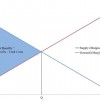 When analyzing environmental problems, economists consider both the benefits and costs of actions. If benefits exceed costs then economic theory supports that action. For example, if the total benefits of conserving land exceed the costs then cost-benefit analysis would support conservation of the land. However, great care must be taken to accurately identify and quantify benefits and costs to determine whether an action is cost-benefit justified. Stakeholders may have an incentive to overstate costs or benefits, in order to influence decision-making. This 5-page fact sheet was written by Elizabeth F. Pienaar, and published by the UF Department of Wildlife Ecology and Conservation, September 2013.
When analyzing environmental problems, economists consider both the benefits and costs of actions. If benefits exceed costs then economic theory supports that action. For example, if the total benefits of conserving land exceed the costs then cost-benefit analysis would support conservation of the land. However, great care must be taken to accurately identify and quantify benefits and costs to determine whether an action is cost-benefit justified. Stakeholders may have an incentive to overstate costs or benefits, in order to influence decision-making. This 5-page fact sheet was written by Elizabeth F. Pienaar, and published by the UF Department of Wildlife Ecology and Conservation, September 2013.
http://edis.ifas.ufl.edu/uw383

